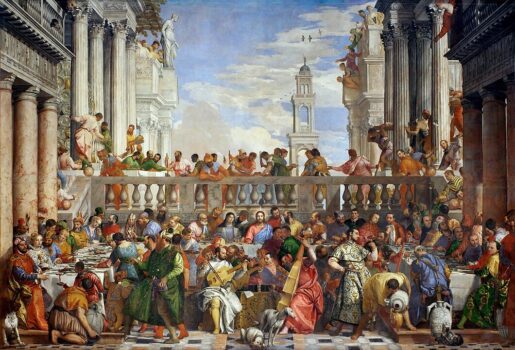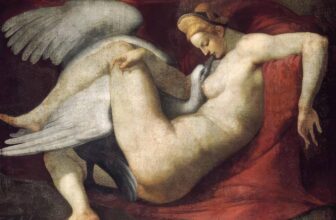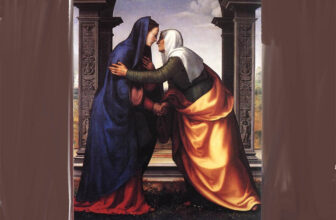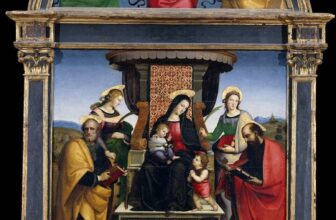Why is The Wedding at Cana Painting Famous
The world of art is filled with iconic paintings that have captured the imagination of people for centuries. One such masterpiece is The Wedding at Cana, a grand and intricate painting by the Italian Renaissance artist Paolo Veronese. This artwork, filled with historical, religious, and artistic significance, continues to fascinate audiences worldwide. But why is The Wedding at Cana painting famous? Is it truly a Renaissance masterpiece? What deeper messages does it hold? Let’s explore the details, the meaning, and the extraordinary value of this painting.
The Wedding at Cana is renowned for multiple reasons. Firstly, its sheer size is breathtaking; measuring approximately 32.8 feet (10 meters) wide and 22 feet (6.7 meters) tall, it is one of the largest paintings housed in the Louvre Museum in Paris. The immense scale creates an overwhelming experience for viewers, making them feel as if they are part of the grand banquet.
Secondly, Veronese’s exquisite use of color, light, and composition demonstrates the height of Renaissance artistry. He meticulously portrays over 130 figures in a dynamic and lively arrangement, blending biblical themes with the opulence of 16th-century Venetian society. The painting is filled with detailed facial expressions, lavish attire, and a sense of movement that brings the scene to life.
Another reason for its fame is its historical and religious significance. It depicts the biblical story of the wedding feast at Cana, where Jesus performed his first miracle, turning water into wine. This moment is not only pivotal in Christian teachings but also symbolic of divine transformation and abundance.
Furthermore, the painting has an intriguing history. Originally commissioned for the Benedictine Monastery of San Giorgio Maggiore in Venice in 1563, it was later seized by Napoleon’s troops in 1797 and transported to France. Today, it remains one of the Louvre’s most treasured pieces, displayed directly opposite the Mona Lisa, creating a striking contrast between two of the museum’s most famous works.
Is The Wedding at Cana a Renaissance Painting?
The Wedding at Cana is undoubtedly a Renaissance painting. Created in 1563 during the height of the Italian Renaissance, it embodies the artistic principles of the period, including perspective, symmetry, and a deep understanding of human anatomy and expression.
Veronese was part of the Venetian school, a movement within the Renaissance known for its rich color palettes, grand compositions, and emphasis on luxurious settings. Unlike the more structured and linear compositions of Florentine painters like Leonardo da Vinci, Venetian artists like Veronese, Titian, and Tintoretto focused on dynamic movement and the interplay of light and color.
One of the key Renaissance elements in The Wedding at Cana is its sophisticated use of perspective. The architectural background, inspired by classical Roman and Greek styles, creates a sense of depth, drawing the viewer’s eye into the scene. The figures are arranged in a way that guides attention toward the central focus, Jesus and Mary, subtly emphasizing the miracle taking place amidst the grandeur of the feast.
What is the Main Message of The Wedding at Cana?
At its core, The Wedding at Cana conveys themes of divine intervention, transformation, and the joy of celebration. The painting captures the moment when Jesus, at the request of his mother Mary, turns water into wine. This miracle is significant in Christian teachings as it marks the beginning of Jesus’ public ministry, demonstrating his divine power and foreshadowing the Eucharist.
Beyond its religious message, the painting also reflects Renaissance ideals of humanism and beauty. The elaborate banquet setting, filled with musicians, aristocrats, and servants, celebrates the grandeur of life and human achievements. The inclusion of Veronese himself among the musicians, along with other notable Venetian figures, suggests a blending of the sacred and the worldly, a hallmark of Renaissance art.
Additionally, the painting highlights the concept of abundance and generosity. The overflowing feast, the detailed fabrics, and the endless supply of wine symbolize the idea that divine grace is limitless, providing for all who believe.
What Was Lacking During the Wedding at Cana?
The primary issue at the wedding in Cana, as depicted in the biblical account (John 2:1-11), was the shortage of wine. Running out of wine at a wedding in ancient Jewish culture was a serious social embarrassment, as it signified poor hospitality and could even bring shame to the hosts.
Mary, the mother of Jesus, noticing the lack of wine, intervenes and asks Jesus to help. Initially hesitant, Jesus ultimately performs his first miracle, instructing the servants to fill large stone jars with water, which he then turns into fine wine. This act not only saves the wedding celebration but also serves as a testament to Jesus’ divine nature and his willingness to provide for people’s needs.
The shortage of wine symbolizes human limitations and the inability to achieve true fulfillment without divine assistance. The transformation of water into wine represents the transition from the old covenant (law and rituals) to the new covenant of grace brought by Christ.
What Does the Wine Symbolize in The Wedding at Cana?
In Christian theology, wine holds deep symbolic meaning. In the context of The Wedding at Cana, it represents several key themes:
- Divine Blessing and Abundance: The miracle demonstrates that God’s grace is abundant and freely given. Jesus doesn’t just provide a small amount of wine—he creates an excess, emphasizing God’s generosity.
- Transformation and Renewal: The shift from water to wine signifies spiritual transformation, highlighting the idea that Jesus has the power to change lives and bring new meaning.
- Foreshadowing of the Eucharist: The wine prefigures the Last Supper, where Jesus institutes the sacrament of communion. It symbolizes his blood, which will be shed for humanity’s salvation.
- Joy and Celebration: Wine is often associated with joy, feasting, and communal bonding. This miracle underscores the importance of joy in spiritual life and the blessings of faith.
Veronese captures this symbolism through the detailed expressions of the guests, the luxurious setting, and the subtle placement of Jesus at the center of the commotion.
How Much is The Wedding at Cana Painting Worth?
Given that The Wedding at Cana is housed in the Louvre Museum and is considered priceless, its exact monetary value is difficult to determine. However, if it were ever to be sold, experts estimate that it could be worth hundreds of millions of dollars, if not more. Considering the historical, artistic, and cultural significance, it would likely be one of the most expensive paintings in the world.
For reference, Salvator Mundi by Leonardo da Vinci was sold for $450 million in 2017. Given The Wedding at Cana’s size, fame, and importance, it could command an even higher price in the art market.
Where is The Wedding at Cana Painting Located?
Today, The Wedding at Cana is displayed in the Louvre Museum in Paris, France. It is located in the same room as the Mona Lisa, making it one of the most visited artworks in the world. Originally created for the refectory of the Benedictine Monastery in Venice, it was looted by Napoleon’s army in 1797 and transported to France, where it has remained ever since.
The Louvre showcases the painting in its full grandeur, allowing visitors to marvel at its details, colors, and historical significance. While there have been discussions about returning the painting to Italy, it remains one of the crown jewels of the French art collection.
The Wedding at Cana by Paolo Veronese is more than just a painting; it is a visual masterpiece rich with history, symbolism, and artistic brilliance. It continues to captivate audiences with its grandeur, storytelling, and theological depth. Whether viewed as a Renaissance wonder, a biblical narrative, or a celebration of life’s abundance, it remains one of the most significant artworks in history. Its presence in the Louvre ensures that generations to come will continue to admire and interpret its beauty and meaning.




